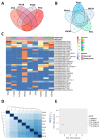LCM-RNAseq Highlights Intratumor Heterogeneity and a lncRNA Signature from Archival Tissues of GH-Secreting PitNETs
- PMID: 39596626
- PMCID: PMC11593583
- DOI: 10.3390/genes15111426
LCM-RNAseq Highlights Intratumor Heterogeneity and a lncRNA Signature from Archival Tissues of GH-Secreting PitNETs
Abstract
Background: This study explores the potential for hidden variations within seemingly uniform regions of growth hormone-secreting pituitary neuroendocrine tumors (GH-PitNETs). We employed archived tissue samples using Laser Capture Microdissection Sequencing (LCM-RNAseq) to probe the molecular landscape of these tumors at a deeper level.
Methods: A customized protocol was developed to extract, process, and sequence small amounts of RNA from formalin-fixed, paraffin-embedded (FFPE) tissues derived from five patients with GH-secreting PitNETs and long-term follow-up (≥10 years). This approach ensured precise isolation of starting material of enough quality for subsequent sequencing.
Results: The LCM-RNAseq analysis revealed a surprising level of diversity within seemingly homogeneous tumor regions. Interestingly, the 30 most highly expressed genes included the well-known long noncoding RNA (lncRNA) MALAT1. We further validated the levels of MALAT1 and of other tumor-associated lncRNAs using digital droplet PCR.
Conclusions: This study demonstrates the potential of LCM-RNAseq to unlock hidden molecular diversity within archived pituitary tumor samples. By focusing on specific cell populations, we identified lncRNAs expressed at different levels within the tumors, potentially offering new insights into the complex biology of GH-secreting PitNETs. This evidence prompts further research into the role of lncRNAs in pituitary neuroendocrine tumor aggressiveness and personalized treatment strategies.
Keywords: GH-secreting pituitary neuroendocrine tumor; RNA sequencing; biomarkers; laser capture microdissection; precision medicine.
Conflict of interest statement
The authors declare no conflicts of interest.
Figures

References
-
- Lloyd R.V., Qian X., Jin L., Ruebel K., Bayliss J., Zhang S., Kobayashi I. Analysis of Pituitary Cells by Laser Capture Microdissection. In: Murray G.I., Curran S., editors. Laser Capture Microdissection. Humana Press; Totowa, NJ, USA: 2005. pp. 233–241. - PubMed
-
- Nakamura N., Ruebel K., Jin L., Qian X., Zhang H., Lloyd R.V. Laser Capture Microdissection for Analysis of Single Cells. In: Thornhill A., editor. Single Cell Diagnostics. Volume 132. Humana Press; Totowa, NJ, USA: 2007. pp. 11–18. Methods in Molecular MedicineTM. - PubMed
MeSH terms
Substances
Grants and funding
- 2022WWY7AA to AP/Italian Ministry of Education, University and Research
- PRIN2017S55RXB to AF/Italian Ministry of Education, University and Research
- EU funding within the MUR PNRR "National Center for Gene Therapy and Drugs based on RNA Technology" (Project no. CN00000041 CN3 RNA) to AF/Italian Ministry of Education, University and Research
- RF-2019-12370266 to AP/Italian Ministry of Health
- Progetto IMMUNHUB Regione Lombardia and Ricerca Corrente - Progetto di Rete Aging "Promising" Ricerca Corrente Ministero della Salute 2021 to C.Ga/Italian Ministry of Health
LinkOut - more resources
Full Text Sources

